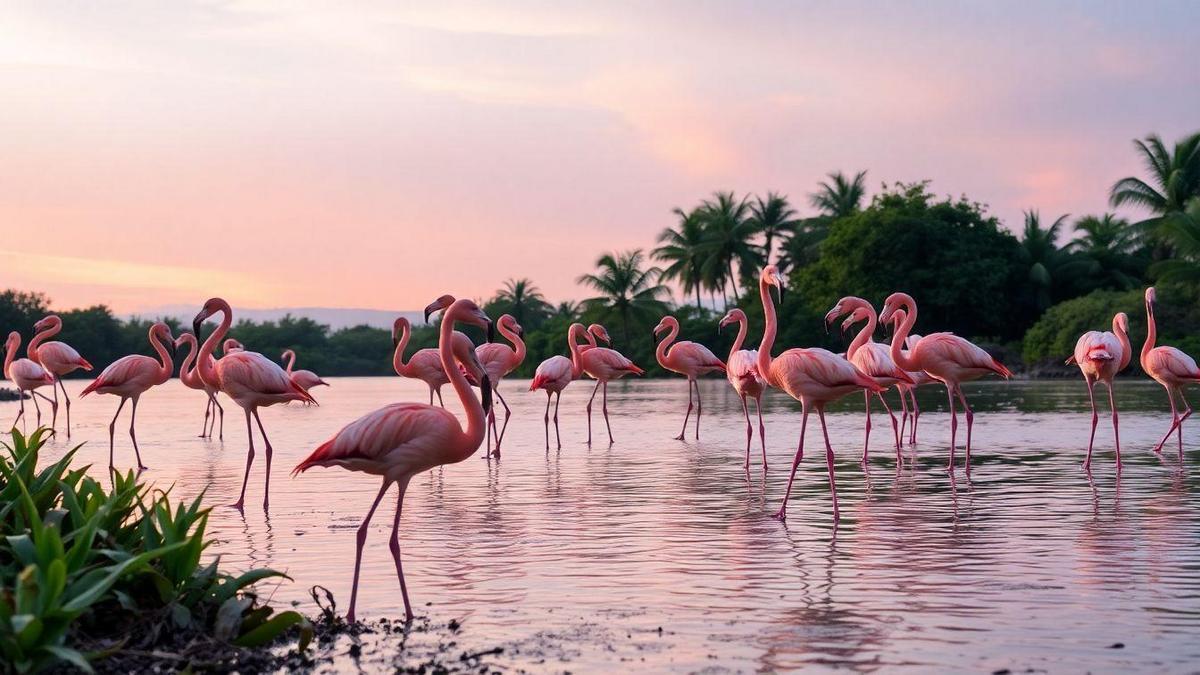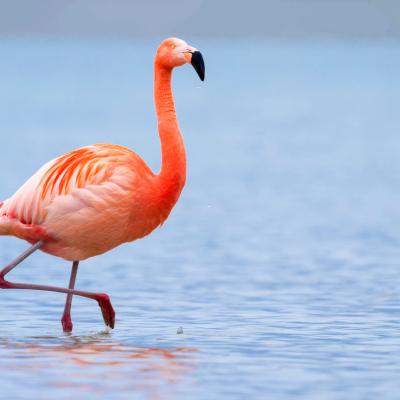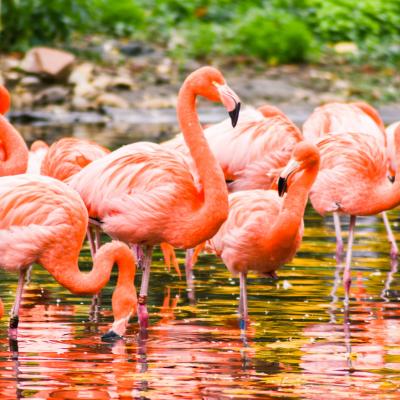Anúncios
The pink coloration of flamingos is one of the most striking traits of these fascinating birds. However, this color is not natural from birth; it is acquired over time. The secret lies in a diet rich in special pigments called carotenoids.
Understanding how diet directly influences the appearance of flamingos leads us to a connection between biology, ecology, and behavior. The coloration becomes an indicator of health, vitality, and reproductive success. This phenomenon reveals how even the most beautiful details of nature have functional and profound origins.
Anúncios

How flamingos get their pink color
Flamingos are among the most recognizable birds in the world, not only for their long legs and distinct beaks but primarily for their vibrant pink coloration. The pink hue of flamingos is not innate; it results from their diet and the pigments they consume. These birds primarily feed on algae, brine flies, and small crustaceans, which are rich in carotenoids — a type of pigment that can impart a pink or reddish hue. When flamingos ingest these carotenoids, their bodies metabolize them and deposit the pigments in their feathers, skin, and even their beaks. This process is known as carotenoid pigmentation.
The intensity of a flamingo’s color can vary significantly depending on its diet. For example, flamingos that consume a diet rich in carotenoids display a much more vibrant pink color compared to those with a diet lower in carotenoids. This dietary influence is not just an aesthetic matter; it plays a crucial role in the birds’ health and reproductive success. The more vibrant the color, the more attractive the flamingo is to potential mates, making the pink coloration an important factor in their mating rituals.
Furthermore, the process by which flamingos achieve their pink coloration is fascinating. When these birds ingest carotenoids, the pigments are broken down in their digestive systems and then absorbed into the bloodstream. Once in the bloodstream, these pigments are transported to various tissues, including feathers, skin, and even the liver. The liver plays a significant role in processing these pigments, ensuring they are used efficiently and deposited where needed. This intricate biological process highlights the connection between diet and physical appearance in these magnificent birds.
Interestingly, the color of flamingos can also change based on their age and the environment they inhabit. Young flamingos are born with gray feathers, and it is only as they mature and begin consuming a carotenoid-rich diet that they develop their iconic pink coloration. Environmental factors, such as the availability of carotenoid-rich food sources, can also impact the vibrancy of their color. In areas where food is scarce or low in carotenoids, flamingos may appear paler or even white. This adaptability demonstrates the resilience of these birds and their dependence on their habitat for survival.

The Origin of the Flamingos’ Pink Color
The pink color of flamingos comes from their diet, which is rich in carotenoids. These pigments are present in organisms such as algae and crustaceans. When ingested, they are processed by the birds’ bodies.
The digestive system breaks down the carotenoids and absorbs them into the bloodstream. Then, they are transported to specific parts of the body, such as feathers and skin. The liver plays an essential role in this process.
Young flamingos are not born colorful: they have gray plumage. Over time, and with an appropriate diet, they become vibrantly pink. This highlights the direct relationship between diet and appearance.
This transformation is not instantaneous and can take months or even years. It depends on the amount of pigment regularly ingested. The natural cycle reveals the importance of diet in the species’ biology.
Benefits of understanding why flamingos are naturally pink
Understanding why flamingos are naturally pink offers numerous advantages, especially in the fields of biology, ecology, and conservation. First, it provides insight into the dietary and behavioral needs of these birds. By studying their eating habits and the types of foods that contribute to their coloration, researchers can better understand the ecological requirements of flamingos and the health of their habitats. This knowledge is crucial for conservation efforts, as it helps identify critical feeding areas that need protection to ensure the survival of flamingo populations.
Additionally, understanding the link between diet and coloration can shed light on the broader implications of environmental and climate changes. As ecosystems evolve due to factors like climate change, pollution, and habitat destruction, the availability of carotenoid-rich food sources may be affected. This can lead to changes in flamingo populations and their reproductive success. By monitoring these changes, scientists can gain valuable insights into ecosystem health and the impact of human activities on wildlife.
Moreover, the study of flamingo coloration can contribute to advances in the fields of nutrition and health. Carotenoids are known for their antioxidant properties and potential health benefits in various species, including humans. By understanding how flamingos metabolize these pigments, researchers can explore their potential applications in nutrition and medicine. This research may lead to new dietary recommendations or supplements that harness the benefits of carotenoids, further bridging the gap between animal biology and human health.
Lastly, the vibrant pink coloration of flamingos serves as a powerful symbol of biodiversity and the importance of preserving natural habitats. By raising awareness about the factors that contribute to their color, we can promote greater appreciation for the interconnectedness of species and ecosystems. This understanding can inspire individuals and communities to take action in protecting the environment and supporting conservation initiatives, ultimately benefiting not only flamingos but a wide range of wildlife.
How to learn more about flamingos’ color and diet

Learning more about the color and diet of flamingos can be an enriching experience, allowing enthusiasts and researchers to delve into the fascinating world of these unique birds. One of the best ways to begin this journey is by visiting local zoos or wildlife sanctuaries that house flamingos. Observing these birds in person offers the opportunity to see their coloration up close and learn about their behavior from knowledgeable staff. Many facilities offer educational programs and presentations that highlight the importance of flamingos in their ecosystems and the role their diet plays in their vibrant appearance.
Another effective way to learn about flamingos’ color and diet is through literature and documentaries. Numerous books, articles, and scientific journals explore the biology and ecology of flamingos, providing valuable insights into their feeding habits, habitat preferences, and the science behind their coloration. Documentaries often showcase the beauty of these birds in their natural habitats, illustrating the challenges they face and the efforts being made to conserve them. These visual narratives can be both educational and inspiring, encouraging viewers to take an interest in wildlife conservation.
Engaging with online resources can also enhance your understanding of flamingos. Websites dedicated to ornithology, wildlife conservation, and environmental education often feature articles, videos, and interactive content about flamingos and their ecosystems. Social media platforms can serve as valuable tools for connecting with experts, organizations, and other enthusiasts who share a passion for these birds. Following conservation groups and wildlife photographers can provide a steady stream of information and updates about flamingo populations and conservation efforts.
Participating in citizen science projects can further deepen your understanding of flamingos and their habitats. Many organizations invite volunteers to help collect data, monitor, and engage in research initiatives focused on flamingo populations. By getting involved in these efforts, you can contribute to scientific knowledge while gaining hands-on experience in the field. This active participation not only enriches your understanding of flamingos but also fosters a sense of connection to the natural world and the importance of protecting it.
In summary, learning more about the color and diet of flamingos involves a combination of observation, research, and active engagement with conservation efforts. By exploring various avenues, such as visiting zoos, reading literature, using online resources, and participating in citizen science projects, individuals can gain a comprehensive understanding of these remarkable birds and the factors that contribute to their stunning pink coloration.
Did you enjoy learning about why flamingos are naturally pink?
Flamingos are truly remarkable creatures, and their pink coloration is just one of many fascinating aspects of their biology. Understanding the science behind their color not only enhances our appreciation for these birds but also highlights the intricate connections between diet, environment, and health. The journey of discovering why flamingos are pink opens a world of knowledge about the natural world and the delicate balance that sustains it.
If you found this exploration of flamingo coloration intriguing, there is much more to discover about these birds and their habitats. From their unique social structures to their migratory patterns, flamingos offer endless opportunities for learning and appreciation. Dive deeper into the wonders of nature, and you may find yourself inspired to take action in support of wildlife conservation and environmental protection.
Frequently Asked Questions
Why are flamingos naturally pink?
Flamingos are naturally pink because of the food they eat.
They feed on small crustaceans and algae, which have pigments called carotenoids.
What are carotenoids?
Carotenoids are colors we find in fruits and vegetables.
These pigments give flamingos their vibrant color and also other animals.
What color are flamingos when they are born?
Flamingos are born gray.
Over time, their color changes to pink, thanks to their diet.
Does the color of flamingos change throughout the year?
Yes, the color of flamingos can change.
They become more or less colorful depending on what they eat.
Can flamingos be other colors?
Yes, if flamingos don’t eat crustaceans and algae, they can be white or gray.
Their color depends a lot on their diet!
